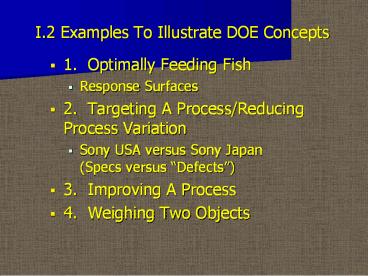I.2 Examples To Illustrate DOE Concepts - PowerPoint PPT Presentation
1 / 25
Title:
I.2 Examples To Illustrate DOE Concepts
Description:
Title: I.2 Examples To Illustrate DOE Concepts Last modified by: grego Document presentation format: On-screen Show (4:3) Other titles: Times New Roman MS P ... – PowerPoint PPT presentation
Number of Views:81
Avg rating:3.0/5.0
Title: I.2 Examples To Illustrate DOE Concepts
1
I.2 Examples To Illustrate DOE Concepts
- 1. Optimally Feeding Fish
- Response Surfaces
- 2. Targeting A Process/Reducing Process
Variation - Sony USA versus Sony Japan(Specs versus
Defects) - 3. Improving A Process
- 4. Weighing Two Objects
2
I.2 Examples To Illustrate DOE Concepts
- 5. Baking Bread
- 6. Mitigating Noise Factors
- Using Interactions Between Noise Factors and
Control Factors To Robustify A Process - 7. Comparing Tires
3
Example 1Fitted Response Surface - With Design
Points
4
Example 2Targeting a Process/Reducing Variation
5
Example 2Accuracy versus Precision
6
Example 2Sony USA vs Sony JAPAN
7
Example 2What is the enemy?
- VARIATION (Nonuniformity of Product)
- Why isn't it just defects?
- Well, for example,
- 1. What was tolerable this week may not be next
week if your competitor has reduced the variation
of their process. - 2. Oftentimes the definition of a defect is that
it does not meet spec's. Since spec's are
manmade, they are subject to the frailties
therein.
8
Example 2Statistical Thinking(Snee, 1990)
- Improvement Comes From Finding Out
- 1. Where The Variation Is
- 2. What Kind Exists
- 3. How Much There Is
- 4. How It Can Be Reduced
- Deming - Reduce Variation to Improve Quality and
the Process - Taguchi - Design Product to Reduce Functional
Variation
9
Example 3Improving a Process
- Goal - Determine which factors affect the mean of
the process and which ones affect the variation. - LOOK FOR (UNUSUAL) PATTERNS IN THE DATA
10
Example 3Improving a Process
- Which Factors Affect
- Accuracy?
- Precision?
11
Example 4Weighing Two Objects(Hotelling via
Daniel)
- M A E
- M ? Measured Weight
- E ??Error
12
Example 4Weighing Two Objects
- Description Of The Problem
- You Have Two Objects To Weigh On A Counter
Balance Scale. - What Are Some Different Ways That You Weigh The
Objects And Still Be Able To Calculate The
Weights? - What Is The Best Way To Do It If You Are Only
Allowed Two Weighings (Best So That The Error Of
The Measured Weight Is Made As Small As Possible)?
13
Example 4Hidden Replication
- With A Properly Designed Experiment You Can Make
The Data Work Twice For You.
14
Example 5Baking Bread
- Here We Use Design Principles To Discover What
Factors In A Bread Recipe Affect Some Responses
Of Interest. Two Designs Are Considered. The
First Is When The Factors Are Changed One At A
Time (OAT). The Second Design Is A Factorial
Design.
15
Example 5Factors and Responses
- Factors
- A. Cake (-) or Dry () Yeast
- B. Water Temp (Hi , Lo -)
- C. Amount of Sugar (Two Levels -,)
16
Example 5Factors and Responses
- Responses (Yes or No)
- 1. How Well Did Yeast Proof (Froth Doubles
Volume) - 2. Rises Adequately(Doubles Volume Within An
Hour) - 3. Second Rising Is Adequate
17
Example 5OAT Design
18
Example 5OAT Design Responses
- What Factors Affect
- Response 1?
- Response 2?
- Response 3?
19
Example 5Factorial Design
20
Example 5Factorial Design Responses
- What Factors Affect
- Response 1?
- Response 2?
- Response 3?
21
Example 5Detecting Interactions
- From The First Design, We Discovered That Factor
B Affected Response 1 And That Factor C Affected
Response 2. But, Because It Was A OAT Design, We
Could Not Pick Up On The Interaction Between
Factors A And C Which Affected Response 3. But
It Was Detected By The Factorial Design.
22
Example 6Mitigating Noise Factors
- Factors
- Machines 10 () and 16 (-)
- Treatment
- Silicone
- Operators
- Estella (-)
- Donald ()
- Response
- Number of picks (snags)
23
Example 6Cube PlotWhat Can We Learn From This
Plot?
24
Example 7Comparing Tires
- Which of the two designs on the next slide is
more appropriate for comparing four brands of
tires? - Why?
25
Example 7Comparing Tires
DESIGN 1 Car
Tire
Position 1 2 3 4 I a b a b II b a b a III c d c
d IV d c d c DESIGN 2 I a b c d II b a d c I
II c d a b IV d c b a































